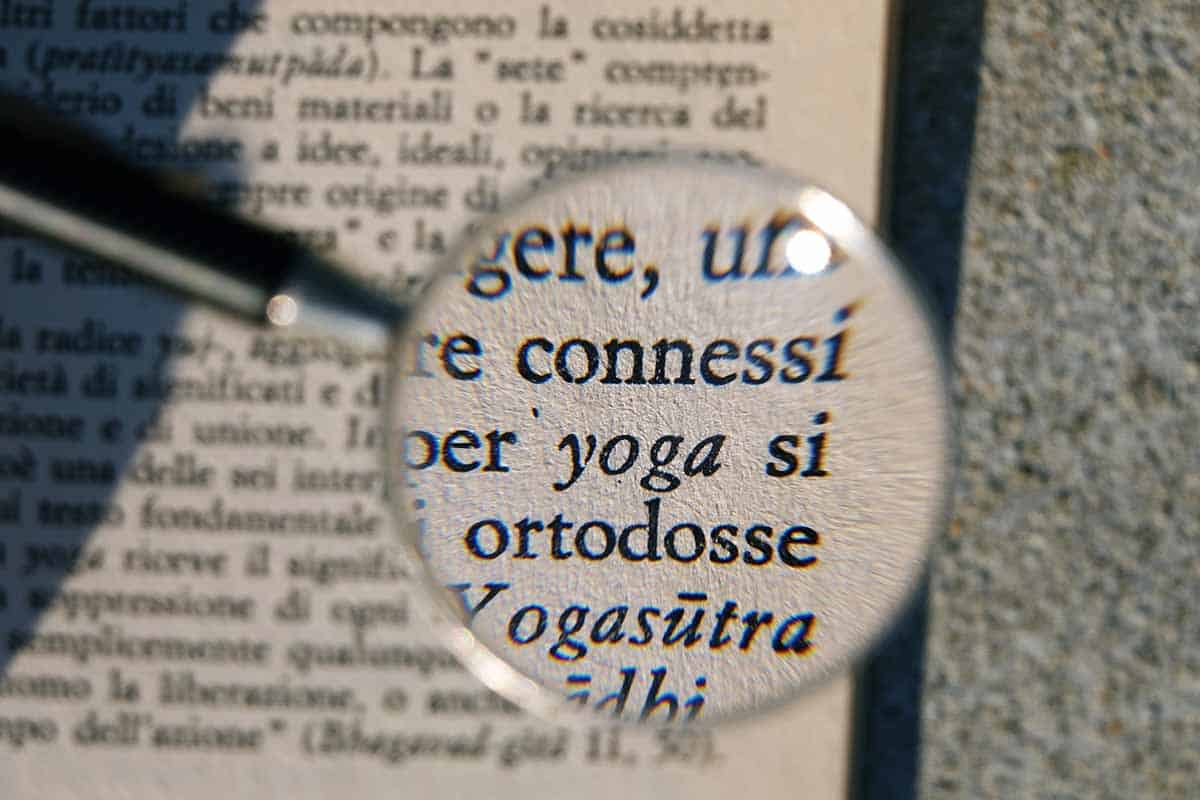
oga isn’t just a cool new thing that celebrities and workout trainers are doing. Although the yoga “trend” may have recently become more popular, the goal has always remained the same: to achieve enlightenment and liberation. While practicing yoga poses is a great way to achieve this, one will fall short without the proper yoga sutras in mind.
Yoga sutras were created by a man named Patanjali in the 400 C.E. era. The goal of the book was to act as a guide for yogis and is referred to as the “basis of yoga philosophy.” The book, filled with 196 sutras divided into four chapters (padas), guides yogis on how they can ultimately achieve freedom while completely controlling their minds and body.
If you’re new to the world of yoga and want to take your experience to the next level, one way to do it is with the yoga sutra. Below, you will find all of the important information about the yoga sutra, from what it is to how it’s organized. Most importantly, you’ll learn why it’s a book every yogi should have in their inventory.
Article Topics
What are the Yoga Sutras of Patanjali, and What is Their Purpose?
Anyone who practices yoga knows that the goal extends beyond agility and health it is a spiritual journey. And while proper breathing techniques, meditation, and poses are all key elements to yoga, one should not forget the importance of the yoga sutras.
The Yoga Sutras of Patanjali are known as the “basis of yoga philosophy.” It is a book written by Patanjali that dates back to 400 C.E. Inside is a collection of 196 verses, organized into four chapters (otherwise known as “padas”).
The goal of the Yoga Sutras of Patanjali is to help yogis and yoginis attain overall wisdom. It acts as a guide for newcomers and novice yogis alike to develop their yogi powers and reach liberation.
Throughout the Yoga Sutras, there are many lessons to be learned, all of which help the yogi through their spiritual journey. By the end of the book, yogis should have obtained self-realization, wisdom, and the power to overcome their pitfalls in this life.
Needless to say, the Yoga Sutras of Patanjali should be a regular part of your yoga journey. However, keep in mind that the book is open to interpretation, and no two people will have the same thought, reaction, or lesson learned. This may have been done purposefully, as it is said the original book was difficult to interpret even for humans alive when it was written.
What do the Yoga Sutras Mean?
The meaning behind each sutra is entirely different, but with a mutual goal: to teach a yogi or yogini how to ultimately achieve enlightenment. The sutra meanings are meant to act as a guideline, offering wisdom, guidance, and guidelines to achieve a purposeful life.
While each sutra is open to interpretation, the bulk of the authoritative text is to simply teach yogis how to perform yoga the “right” way so they end with liberation.
For example, “Drashtr drshyayoh samyogo heya hetuh” explains that the bulk of all suffering has to do with an inability to distinguish between the actual truth and what appears to be the truth. It all comes down to perception. Patanjali’s goal is to encourage the yogi to separate the two to clear their mind and see things as they truly are, offering peace.
“atah pratyakcetanadhigamah api antarayabhavas ca” is another well-known yoga sutra with similar meaning. Here, Patanjali explains that through inner consciousness and knowing yourself to the fullest, you can reduce obstacles in your life. As it says, the more you turn inwards to yourself, the more will be revealed and the closer you will become to your true self.
What are the First 4 Yoga Sutras?
Inside the Yoga Sutras is a collection of 196 verses organized into four chapters. Upon opening the first chapter, known as Samadhi pada, you will be greeted by four sutras that begin to explain what yoga truly is.
- Sutra 1.1 – Atha Yoga anushasanam: This sutra is the opening to the book. It is translated to “Now and discipline,” essentially saying that you will now learn the discipline of yoga (amongst other elements).
- Sutra 1.2 – Yogaha chitta vritti nirodhah: The definition of these words are mind, modifications, and control. This describes yoga perfectly, as it is the way to control and modify the mind. That said, sutra 1.2 describes the meaning of yoga itself.
- Sutra 1.3 – Tada drashtuh swarupe awasthanam: Piggybacking off of sutra 1.2, sutra 1.3 essentially explains what happens when a yogi controls their mind – they achieve a true state of being.
- Sutra 1.4 – Vritti sarupyam itaratra: In the fourth sutra, Patanjali explains that when you are not in control of your mind, your thoughts can overtake you, which is why it is so important to meditate.
How are the Yoga Sutras Organized
The Yoga Sutras of Patanjali are divided into four chapters, including Samadhi Pada, Sadhaa Pada, Vibhuti Prada, and Kaibalya Pada. Of these four chapters are 196 sutras, or verses, for yogis to learn and apply to their yoga.
The organization of sutras and chapters was not done by accident, though. The sutras were designed in a very specific matter to ensure the reader could learn and apply the sutras to their life.
For example, Patanjali starts with an introduction to yoga, what it is, and what the end goal is. It is here that yogis get a prelude to what their journey will be all about. In the following chapter, He describes the details of the path and what you need to do to reach enlightenment through the unconscious.
From there, Patanjali describes paranormal powers which can be achieved through yogic discipline. Finally, the last chapter lays out the path that needs to be taken to achieve the ultimate goal of yoga – freedom.
That said, the organization of the sutras works as a map or guide for yogis and yoginis to achieve liberation. It starts with a clear introduction and takes the reader on an applicable journey that spawns wisdom, self-realization, and liberation.
What are the Chapters of the Yoga Sutras?
The goal of the Yoga Sutras is to help yogis on their spiritual journey and encourage self-realization and wisdom. Inside the book, there are 196 sutras that are up for original interpretation. That said, the yoga sutras can have many meanings, depending on who’s reading them.
As a basis, though, the yoga sutras are divided into four chapters with specific meanings:
What else does Santosha offer?
Besides their fantastic online RYT-200 Yoga Teacher Training Certification Course, Santosha offers online continuing education yoga teacher training classes, as well as in-person teacher training programs in beautiful, tropical locations. Let’s take a closer look at these valuable courses.
Samadhi pada
The first chapter sets the stage for new yogis, with 51 sutras describing what yoga is. In this section, you will find a sutra such as Sutra 1.2: “yogas citta-vrtti-nirodhah,” which translates to “yoga is the control of the mind”. This sutra explains the goal of yoga in its entirety – to quiet and calm the mind. To achieve innermost focus while releasing temptations, distractions, and stress of the world around you.
Sadhana pada
This is said to be one of the most important “chapters” of the Yoga Sutras as it explains, in-depth, how to achieve a yogic state of mind. There are 55 sutras in this chapter and introduce the eight “limbs” of yoga. These limbs act as a guide for your spiritual journey and include:
- Yama: Learning how to behave with others, such as not stealing or wasting energy and being truthful.
- Niyama: Principles for how you should live your life, such as remaining pure and being devoted.
- Asana: Obtaining consciousness.
- Pranayama: How to use breathing exercises to expand your life force
- Pratyahara: Being able to turn your senses inward to explore your mind and connect to the inner universe
- Dharana: How you can properly train your mind to meditate
- Dhyana: Perfecting your meditation
- Samadhi: Unity
As you can see, the eight limbs are interconnected and must be learned in order. The first four limbs prepare the mind and body for the three that follow. When these three (Dharana Dhyana and Samadhi) are practiced together, it is known as Sanyama. When the seven are done in harmony, the eighth limb is finally attainable.
Vibhuti pada
In the third chapter, 56 sutras display the pros of yoga and why practicing yoga regularly can be beneficial in your life. For example, one sutra says:
Sutra 3.3: “tad evârtha-mâtra-nirbhâsam svarûpa-sûnyam iva samâdhih,” which is more or less saying that meditation can be challenging and it is difficult to achieve complete deep concentration.
However, it says that learning to achieve deep concentration will altogether provide a new way of thinking. During meditation, you will also learn new things about yourself and how you perceive the world. From there, you can understand what changes may need to take place for a more fulfilling life.
Kaivalya pada
In the final chapter of the Yoga Sutras, one learns about liberation from all types of suffering, especially those found in the outside world.
The Sutra 4.31 describes it perfectly. “tadâ sarvâvaraña-malâpetasya jnânasyânantyâj jneyam alpam.” This sutra explains that by using the eight limbs of yoga, you can remove impurities from within. By doing so, you can reach enlightenment and infinite wisdom, which is the goal of yoga.
Was Patanjali a Buddhist?
Patanjali was around in the 400 C.E. era, making it difficult to decipher certain details of the yoga sutras. However, it is noted that the yoga status of Patanjali was written in Buddhist Hybrid Sanskrit as opposed to “classic” Sanskrit, which would lead one to believe that, yes, Patanjali may have been a Buddhist or at least influenced by Buddhist beliefs.
What is Ashtanga yoga, according to Patanjali?
According to Patanjali and his yoga sutras books, the ashtanga is the final limb of the eight limbs of yoga. In fact, ashtanga literally translates to “eight” and “limb.” It is here that a yogi achieves enlightenment and freedom.
Was Patanjali a real person?
Patanjali is believed to have been a sage in India. While he created many works, including Mahabshashya, the yoga sutras are undeniably his most popular book that has influenced the practice of yoga for decades.
Final Words
Achieving enlightenment as a yogi is done through many techniques, including posture (or asanas) and meditation. Still, one aspect that should be added to the spiritual journey is the yoga sutras of Patanjali. There is so much knowledge here! It’s typically a required book for any yogi aspiring to teach through either an in-person or Online Yoga Teacher Training.
This book will guide you through your yogic journey, eventually leading you to enlightenment and liberation, which may otherwise not be obtainable.



